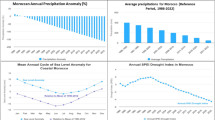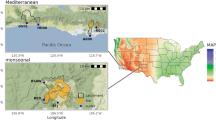Abstract
Riparian buffers in agricultural landscapes should be designed to trap pollutants in overland flow by slowing, filtering, and infiltrating surface runoff entering the buffer via sheet flow. However, observational evidence suggests that concentrated flow is prevalent from agricultural fields. Over time sediment can accumulate in riparian buffers forming berms that restrict sheet flow; these berms ultimately back up surface runoff, resulting in an eventual breakthrough that concentrates overland flow. This study examines the occurrence of concentrated flow paths (CFPs) in riparian buffers at both the field and watershed scale. At the field scale, intensive topographic surveys were conducted at ten field sites in southern Illinois. To assess the prevalence of CFPs at the watershed scale, three watersheds in southern Illinois were selected for walking stream surveys along randomly selected 1,000 m reaches. CFPs were identified in all topographic surveys and all walking stream surveys. Among field sites, concentrated flow accounted for 82.5–100% of the drainage leaving the agricultural fields. Sediment berm accumulation was identified at all field sites and was positively correlated with CFP size. At the watershed scale, CFPs were more abundant in agricultural areas compared to forested land. Results from this study indicate that concentrated flow was prevalent across all study sites at both the field and watershed scale. Thus, surface water quality may suffer in areas with poorly functioning buffers, and managers must consider the occurrence of CFPs when designing and maintaining riparian buffers to protect stream water quality.








Similar content being viewed by others
References
Alberts EE, Neibling WH, Modenhauer WC (1981) Transport of sediment and phosphorus in runoff through cornstalk residue strips. Soil Sci Soc Am J 45:1177–1184
Black CA, Evans DD, White JL, Ensminger LE, Clark FE (1965) Methods of soil analysis. Part 1. Physical and mineralogical properties, including statistics of measurement and sampling. American Society of Agronomy, Madison
Cooper JR, Gilliam JW, Daniels RB, Robarge WP (1987) Riparian areas as filters for agricultural sediment. Soil Sci Soc Am J 51:416–420
Daniels RB, Gilliam JW (1996) Sediment and chemical load reduction by grass and riparian filters. Soil Sci Soc Am J 60:246–251
Dillaha TA, Sherrard JH, Lee D, Mostaghimi S, Shanholtz VO (1988) Evaluation of vegetative filter strips as a best management practice for feed lots. J Water Pollut Control Fed 60:1231–1238
Dillaha TA, Reneau RB, Mostaghimi S, Lee D (1989) Vegetative filter strips for agricultural nonpoint source pollution control. Trans ASAE 32:513–519
Dosskey MG (2001) Toward quantifying water pollution abatement in response to installing buffers on crop land. Environ Manage 28(5):577–598
Dosskey MG, Helmers MJ, Eisenhaur DE, Franti TG, Hoagland KD (2002) Assessment of concentrated flow through riparian buffers. J Soil Water Conserv 57(6):336–343
Environmental Systems Research Institute (1996) Cell-based modeling with GRID. ESRI, California
Environmental Systems Research Institute (2006) ArcGIS 9.2. Redlands, CA
Hayes JC, Barfield BJ, Barnhisel RI (1979) Filtration of sediment by simulated vegetation. Trans ASAE 22(5):1063–1067
Horton RE (1933) The role of infiltration in the hydrologic cycle. EOS Trans Am Geophys Union 14:44–46
Illinois Department of Natural Resources (1997a) Cache River area assessment, volume 1, part 1. Illinois Department of Natural Resources, Champaign
Illinois Department of Natural Resources (1997b) The Cache River Basin: an inventory of the region’s resources. Critical Trends Assessment Program, Illinois
Knight KW, Schultz RC, Mabry CM, Isenhart TM (2010) Ability of remnant riparian forests, with and without grass filters, to buffer concentrated surface runoff. J Am Water Resour Assoc 46(2):311–322
Lee KH, Isenhart TM, Schultz RC, Mickelson SK (1998) Nutrient and sediment removal by switchgrass and cool-season grass filter strips in Central Iowa. Agrofor Syst 44(2):121–132
Lee KH, Isenhart TM, Schultz RC, Mickelson SK (2000) Multispecies riparian buffers trap sediment and nutrients during rainfall simulations. J Environ Qual 29:1200–1205
Lee KH, Isenhart TM, Schultz RC (2003) Sediment and nutrient removal in an established multi-species riparian buffer. J Soil Water Conserv 58:1–8
Lowrance R, Todd R, Fail J, Hendrickson O, Leonard R, Asmussen L (1984) Riparian forests as nutrient filters in agricultural watersheds. Bioscience 34(6):374–377
Lowrance R, Sharpe JK, Sheridan JM (1986) Long-term sediment deposition in the riparian zone of a Coastal Plain watershed. J Soil Water Conserv 41:266–271
Lyons J, Trimble SW, Paine LK (2000) Grass versus trees: managing riparian areas to benefit streams of central North America. J Am Water Resour Assoc 36(4):919–930
Meyer LD, Dabney SM, Harmon WC (1995) Sediment-trapping effectiveness of stiff-grass hedges. Trans ASAE 38(3):809–815
Myers JL, Wagger MG, Leidy RB (1995) Chemical movement in relation to tillage system and simulated rainfall intensity. J Environ Qual 24:1183–1192
Noss RF, Laroe ET, Scott JM (1995) Endangered ecosystems of the United States: a preliminary assessment of loss and degradation. Biological Report 28, United States Department of the Interior, National Biological Service, Washington, DC
Osborne LL, Kovacic DA (1993) Riparian vegetated buffer strips in water quality restoration and stream management. Freshw Biol 29:243–258
Platt SG, Brantley CG (1997) Canebrakes: an ecological and historical perspective. Castanea 62:8–21
Roberts S (2008) Transform your data. Nutrition 24:492–494
Robinson CA, Ghaffarzadeh M, Cruse RM (1996) Vegetative filter strip effects on sediment concentration in cropland runoff. J Soil Water Conserv 50(3):227–230
Schmitt TJ, Dosskey MG, Hoagland KD (1999) Filter strip performance and processes for different vegetation, widths, and contaminants. J Environ Qual 28:1479–1489
Schoonover JE, Williard KWJ, Zaczek JJ, Mangun JC, Carver AD (2005) Nutrient attenuation in agricultural surface runoff by riparian buffer zones in southern Illinois, USA. Agrofor Syst 64:169–180
Schoonover JE, Williard KWJ, Zaczek JJ, Mangun JC, Carver AD (2006) Agricultural sediment reduction by giant cane and forest riparian buffers. Water Air Soil Pollut 169:303–315
Schultz RC, Isenhart TM, Simpkins WW, Colletti JP (2004) Riparian forest buffers in agro ecosystems—lessons learned from the Bear Creek Watershed, central Iowa, USA. Agrofor Syst 61:35–50
Schultz RC, Isenhart TM, Simpkins WW, Udwatta RP, Schultz PL (2009) Riparian and upland buffer practices. In: Garrett HE (ed) North American agroforestry: an integrated science and practice (Second Edition). American Society of Agonomy, Madison, pp 163–218
Soil Survey Division Staff (1993) Soil survey manual. USDA Handbook No. 18. US Government Printing Office, Washington, DC, 138 pp
Sokal RR, Rohlf FJ (1995) Biometry: the principles and practice of statistics in biological research. W.H. Freeman Company, New York
US Department of Agriculture (2000) Land cover of illinois statistical summary 1999–2000. www.agr.state.il.us/gis/stats/landcover/index.htm
Young RA, Onstad CA (1976) Predicting particle size composition of eroded soil. Trans ASAE 19:1071–1075
Author information
Authors and Affiliations
Corresponding author
Rights and permissions
About this article
Cite this article
Pankau, R.C., Schoonover, J.E., Williard, K.W.J. et al. Concentrated flow paths in riparian buffer zones of southern Illinois. Agroforest Syst 84, 191–205 (2012). https://doi.org/10.1007/s10457-011-9457-5
Received:
Accepted:
Published:
Issue Date:
DOI: https://doi.org/10.1007/s10457-011-9457-5




